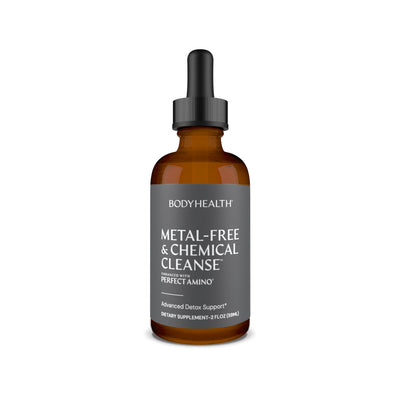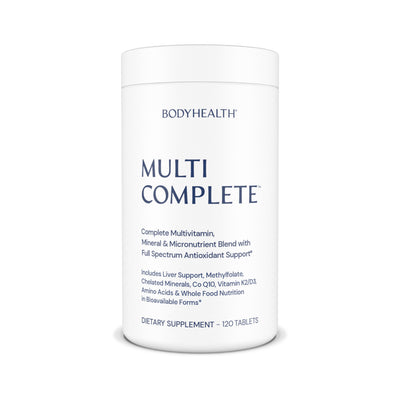How Environmental Toxins Actually Affect Us & Our Children
February 16, 2023 7 min read

The subject of environmental toxins is one I haven’t spoken about in some time, but I need to — because it’s getting worse.
And I don’t mean that as a generality. I mean it on a very real, very personal level for each one of us.
We’ve passed the point where taking “reasonable precautions” or “buying all organic” is enough.
We’re exposed to too many chemicals every day. They’re in our personal care products, the clothes we buy, the fabric of our car seats, and our dishwashing liquids.
We even have toxic heavy metals in our baby foods, and that’s a very real problem.
But we’ve heard all of this before, seen all the stats and figures.
What does it really mean? How does this work, how do these things actually harm us?
And is it really that bad?
Let’s have a real example and you tell me.
Let’s take one toxin that is more toxic, and more widespread, than almost any of the others, in our food and water, and follow it as it enters our body. See where it goes and what it actually does.
WHAT IS GLYPHOSATE & HOW DOES IT ACTUALLY HARM THE BODY?
Glyphosate is many things. And it been around since the 1970’s, growing in use each year.
It’s a neurotoxin, something destructive to nerves. Exactly how destructive depends on how much of it the nerves receive over a certain amount of time.
Neurotoxins can block a nerve impulse, causing things like muscle paralysis or a low heart rate, or speed up nerve channels, causing feelings of crawling in ones own skin, hyperactivity, anxiety, or inability to sleep.
Or it can mess up the network of nerves, causing some parts to speed up and others to slow down, and we may get autism.
Glyphosate is also also an antibiotic, meaning it kills bacteria, any bacteria, good or bad, even the bacteria in your microbiome that are vital for your health, the proper functioning of your body, and even your mood.
The same bacteria that help form our nervous systems when we’re very young.
It also operates on the very important protein Zonulin.
If you remember from this article, Zonulin is the protein that opens the tight junctions between our intestinal cells, the little doorways that allow nutrients to pass from our small intestine into our bloodstream and to the cells in the body where they’re needed.
Glyphosate forces these tight junctions to open and stay open, letting harmful bacteria and viruses into your body before your immune cells have a chance to deal with them.
But it also passes through itself into the bloodstream, and circulates around the body. And your organs also have tight junctions. And glyphosate forces these open as well.
It’s also a hormone disrupter: thyroid, testosterone, adrenaline, estrogen. It disrupts or inhibits the body’s ability to produce or use these hormones, causing all sorts of trouble.
And it harms our mitochondria, the thousands of tiny structures in each one of our cells that are responsible for producing the energy that our body actually uses, something called ATP.
Glyphosate does all of that and more. In fact, there is no aspect of your body it doesn’t affect.
That, and the fact that it’s now one of the most pervasive toxins on the planet, growing in use every year, is why I picked it.
Wait. Stop. Really? Is itreally that bad?
Well, let’s look at it.
It kills anything it touches.
Literally. Any bacteria, any plants.
Dead.
It is the best “weed killer” ever invented, except, of course, to those plants that have been genetically modified to withstand it.
That’s right, if you see that something is GMO, the genetic modification being referred to is often a modification to that plant’s genes to protect it from Glyphosate, which has been done to most of our prime crops now: Wheat, Oats, Corn, Soy, and Cotton.
So they can be sprayed along with the weeds around them, and only the weeds die.
But the crops soak it up. And they pass it on to the animals that fed on them and to you.
Corn and Soy.
These are the top two animal feed crops there are.
They’re also the top two ingredients in almost all processed foods.
And almost all of them are heavily sprayed with glyphosate.
But it didn’t even start as a weed killer.
No, it was originally created as an industrial drain cleaner to clear out the toughest clogs a chemical plant could throw at it.
The only reason they stopped using it was because it would come out of the drains, into waterways, and kill all plant life around it.
So they patented it as an herbicide instead.
How good is it at killing?
It’s in the same family of chemicals as Agent Orange, the chemical we sprayed on Vietnamese forests, completely devastating them even to this day, not to mention causing cancer and a host of other conditions in those individuals close enough to have contact with it.
In fact, Agent orange and Glyphosate were made by the same company — Monsanto, before it was purchased by Bayer.
But what does just a tiny amount do?
Let’s take a piece of pizza.
If this is normal bread, as pretty much any pizza will be these days, then it’s likely soaked with glyphosate.
This is because the wheat the bread was made from is sprayed with glyphosate not once, but twice. First, before planting, and then once more before being harvested in order to dry it out so it's ready for harvest.
The glyphosate is literally soaked into the wheat.
The average pizza contains about 10 parts per million of glyphosate. A pretty tiny amount if you think about it.
But when we add this same amount to a cell culture containing human intestinal tight juncture cells, we see that even this tiny amount starts to degrade this tissue almost immediately upon contact.
Then there’s the paper from 2009, in the journal Chemical Research in Toxicology, showing that low levels of four glyphosate formulations, levels far below what's allowed in agriculture, levels on par with what's in our food… all kill human umbilical, embryonic, and placental cells within 24 hours.
Okay, I’ll stop. Soon.
HOW TOXINS LIKE GLYPHOSATE AFFECT US OVER TIME
Remember how it opens up the doorways in the small intestine, the ones that are supposed to let nutrients through?
Well, what else gets through these tight junctions that Glyphosate forced open?
Oh, maybe some other toxins. Maybe some metals like mercury or aluminum, some micro-plastics, Oh! And some of that glyphosate.
But this is the first time. And it’s so small! You might not even get a tummy ache.
If this little happened once, or even once a month, you’d probably be fine. It’s not too much. You’re a full-grown adult. Your body can handle it.
But what if it’s not a tiny bit once a month? What if it’s once a week? Or daily?
Do you ever eat crackers? Chips? Bread? Non-organic meats? Do you drink Coke or water from the tap? Do you eat non-organic salads?
Well, then we’re not talking once a month.
What happens the next time you have some? And the time after that? And the time after that, until we’re a year or two or ten down the road?
What do we have now?
Well, this problem has been increasing because not only does the glyphosate cause a little more destruction each time, it also builds up in the body.
We now have the cells around these tight junctions in the small intestine starting to degrade due to the glyphosate.
It’s not just opening the tight junctions between the cells. It’s also killing the cells themselves. It is a poison after all.
This means the cells aren’t producing as much of their mucous lining to trap harmful bacteria.
So harmful bacteria get through into the bloodstream and cause minor infections in the body, weakening the immune system bit by bit.
And with all of these toxins coming through, we have the immune system on 24 hour watch, leaving it run down.
So it’s easier to get sick, and takes longer to recover.
And immune responses in the body bring on inflammation which can leave us feeling depressed, exhausted, and in a sort of constant “achey” state.
We’re getting belly aches now. We have indigestion. We’ve got heartburn.
Our digestion of protein decreases. And as the enzymes that make our body work, and the hormones that tell them what to do, are made of proteins, we start having deficiencies and imbalances.
And the whole time we have this glyphosate working on these tight junctions in our body now, like a needle, poking microscopic holes in the tissue.
So we get inflammation, auto-immune disease, dementia, autism, celiac disease, cancer, hormonal imbalances, exhaustion, chronic fatigue, depression, the list goes on.
Okay, I’ll stop now.
But do you understand more how these toxins affect us?
That's just one.
There are many others, just as harmful, that enter our bodies each day: forever chemicals (PFAS), heavy metals, plastics, and even used medical drugs via our local water systems.
They’re very real. And they’re in our environment affecting us and those we love every day.
HOW TO DO WE PROTECT OURSELVES FROM TOXINS IN OUR ENVIRONMENT
There are several ways. The first is to do your very best to only eat certified organic foods and to stay away from processed foods as much as you can.
This will cut down many toxins that would otherwise enter our bodies.
A good water filter is also important, preferably a reverse-osmosis water filter.
When purchasing cleaning agents, or buying personal care products, look for organic ingredients — they do exist — and study up on the toxic ingredients in skin care formulas so you know what to avoid.
But at this point, it’s not just hard to keep them all out, it’s impossible.
There are too many. And they build up inside of us.
We need to get them out, and we need to get them out effectively.
And that’s exactlywhat we’re going to do...
So stay tuned!
Perfect Amino Facebook VIP Group - Join now!Articles by Health Topic
Your Path To Better Health Starts Here!
From in-depth articles on nutritional benefits to updates on new product launches, stay informed and inspired on your journey to optimal health.
*These statements have not been evaluated by the Food and Drug Administration. These products are not intended to diagnose, treat, cure, or prevent any disease.

